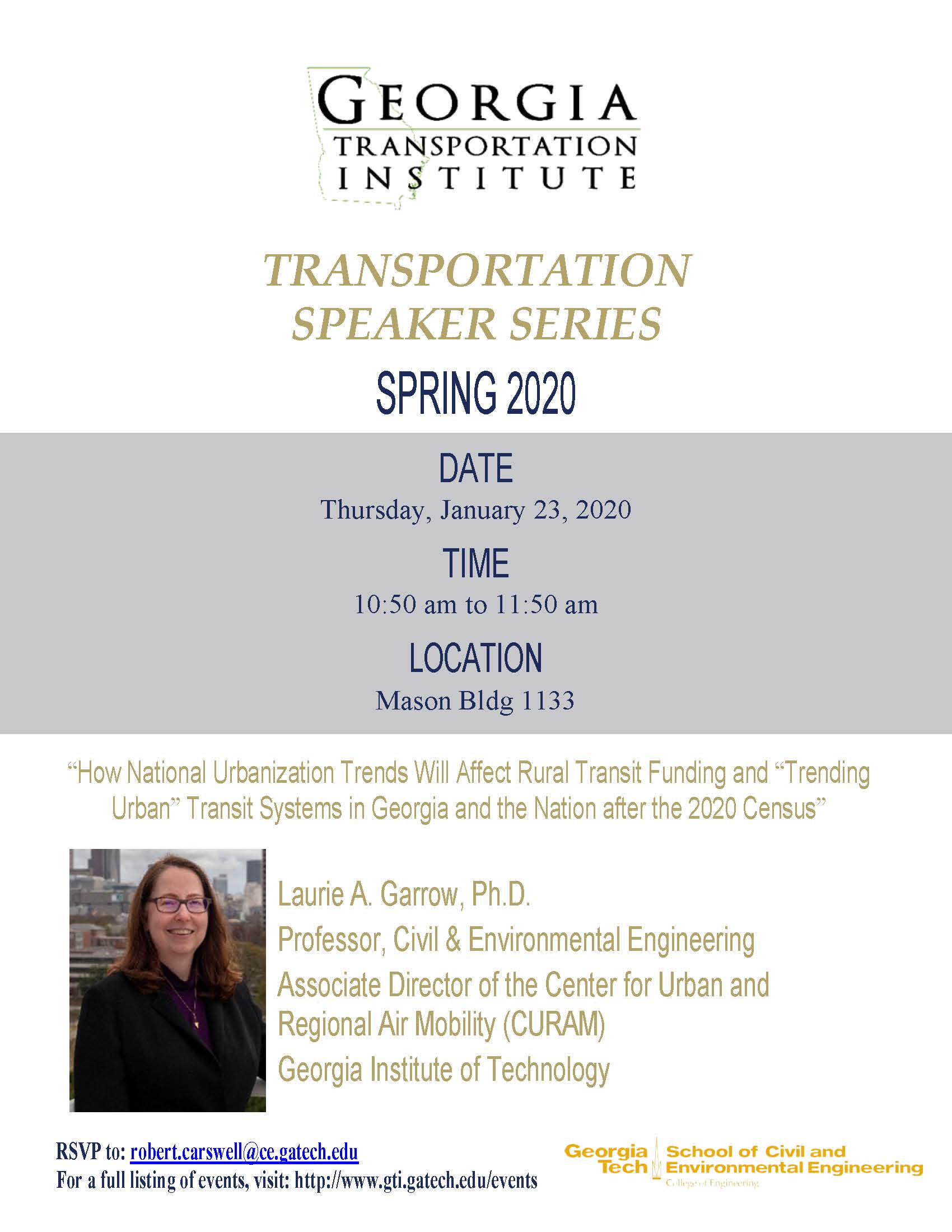Dr. Laurie A. Garrow - "How National Urbanization Trends Will Affect Rural Transit Funding and “Trending Urban” Transit Systems in Georgia and the Nation after the 2020 Census”
The Georgia Transportation Institute welcomes Dr. Laurie Garrow to speak at the Spring 2020 Transportation Speaker series. She is a Professor of Civil and Environmental Engineering and Associate Director of the Center for Urban and Regional Air Mobility (CURAM) at the Georgia Institute of Technology. Dr. Garrow has published articles on airline passengers' behavior, discrete choice methods, and travel demand modeling. She is the author of a text entitled Discrete Choice Models of Air Travel Demand: Theory and Application. Among her leadership Dr. Garrow currently serves on the Board of Directors for two organizations: INFORMS and AGIFORS. She has previously served as President of the Transportation Science and Logistics Society of INFORMS and as Chair of the Aviation Applications Section of INFORMS. Dr. Garrow is the recipient of the ASCE Walter L. Huber Civil Engineering Prize, the CUTC-ARTBA New Faculty Member Award, and an NSF CAREER award. Dr. Garrow has five years of industry experience, including four years as an analyst in the Research and Development Revenue Management Group of United Airlines and one year as an analyst in the Customer Science Unit of Mercer Management Consulting.
If you missed the presentation or want to rewatch or share it, the YouTube link is provided below. You can also review the final report.
YouTube link: https://youtu.be/5tf6BtwA2z0
Final Report: http://garrowlab.ce.gatech.edu
Title: How National Urbanization Trends Will Affect Rural Transit Funding and “Trending Urban” Transit Systems in Georgia and the Nation after the 2020 Census
Abstract:
In the U.S., there are two main sources of transit funding administered by the Federal Transit Administration (FTA). The amount of FTA funding a transit agency receives depends, in part, on whether the agency serves an area that is designated as rural, small urban, or large urban. These designations are defined using the most recent decennial census. Between 2000 and 2010, the percentage of the U.S. population residing in urban areas increased by over 12%. Population forecasts suggest these trends will continue and will be reflected in the 2020 decennial census. In this presentation, we examine how spatial and temporal changes in the U.S. population will impact funding for transit systems in the U.S. after the 2020 decennial census. We use binary logic models and geographic information system (GIS) methods to predict spatial and temporal population changes between 2010 and 2020 and identify which areas of the U.S. will be classified as rural, small urban, or large urban after 2020. We then use this information to forecast funding requirements for the FTA § 5311 and FTA § 5307 programs after the 2020 decennial census and to identify rural areas that could become enveloped into large areas after the 2020 decennial census. The latter is important because rural transit agencies that shift to large urban areas after the 2020 decennial census will lose their ability to use federal funding for operating expenses for two years due to the “100 bus rule.” Results show that amount of additional funding needed for the FTA § 5307 small urban will be $344M–$411M, representing a 28%–33% increase over current levels.

Theme by Danetsoft and Danang Probo Sayekti inspired by Maksimer


































